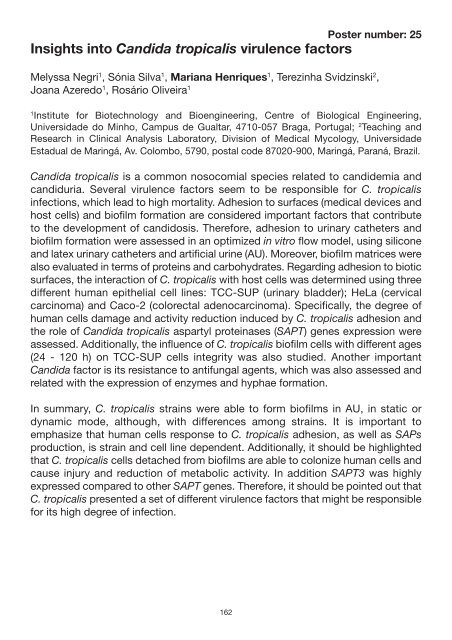Candida Infection Biology – fungal armoury, battlefields ... - FINSysB
Candida Infection Biology – fungal armoury, battlefields ... - FINSysB
Candida Infection Biology – fungal armoury, battlefields ... - FINSysB
Create successful ePaper yourself
Turn your PDF publications into a flip-book with our unique Google optimized e-Paper software.
Poster number: 25<br />
Insights into <strong>Candida</strong> tropicalis virulence factors<br />
Melyssa Negri 1 , Sónia Silva 1 , Mariana Henriques 1 , Terezinha Svidzinski 2 ,<br />
Joana Azeredo 1 , Rosário Oliveira 1<br />
1 Institute for Biotechnology and Bioengineering, Centre of Biological Engineering,<br />
Universidade do Minho, Campus de Gualtar, 4710-057 Braga, Portugal; 2 Teaching and<br />
Research in Clinical Analysis Laboratory, Division of Medical Mycology, Universidade<br />
Estadual de Maringá, Av. Colombo, 5790, postal code 87020-900, Maringá, Paraná, Brazil.<br />
<strong>Candida</strong> tropicalis is a common nosocomial species related to candidemia and<br />
candiduria. Several virulence factors seem to be responsible for C. tropicalis<br />
infections, which lead to high mortality. Adhesion to surfaces (medical devices and<br />
host cells) and biofilm formation are considered important factors that contribute<br />
to the development of candidosis. Therefore, adhesion to urinary catheters and<br />
biofilm formation were assessed in an optimized in vitro flow model, using silicone<br />
and latex urinary catheters and artificial urine (AU). Moreover, biofilm matrices were<br />
also evaluated in terms of proteins and carbohydrates. Regarding adhesion to biotic<br />
surfaces, the interaction of C. tropicalis with host cells was determined using three<br />
different human epithelial cell lines: TCC-SUP (urinary bladder); HeLa (cervical<br />
carcinoma) and Caco-2 (colorectal adenocarcinoma). Specifically, the degree of<br />
human cells damage and activity reduction induced by C. tropicalis adhesion and<br />
the role of <strong>Candida</strong> tropicalis aspartyl proteinases (SAPT) genes expression were<br />
assessed. Additionally, the influence of C. tropicalis biofilm cells with different ages<br />
(24 - 120 h) on TCC-SUP cells integrity was also studied. Another important<br />
<strong>Candida</strong> factor is its resistance to anti<strong>fungal</strong> agents, which was also assessed and<br />
related with the expression of enzymes and hyphae formation.<br />
In summary, C. tropicalis strains were able to form biofilms in AU, in static or<br />
dynamic mode, although, with differences among strains. It is important to<br />
emphasize that human cells response to C. tropicalis adhesion, as well as SAPs<br />
production, is strain and cell line dependent. Additionally, it should be highlighted<br />
that C. tropicalis cells detached from biofilms are able to colonize human cells and<br />
cause injury and reduction of metabolic activity. In addition SAPT3 was highly<br />
expressed compared to other SAPT genes. Therefore, it should be pointed out that<br />
C. tropicalis presented a set of different virulence factors that might be responsible<br />
for its high degree of infection.<br />
162


